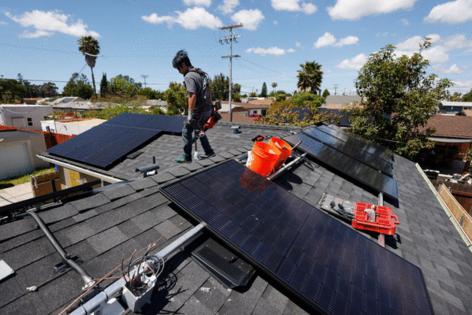California's rooftop solar rules in limbo after state Supreme Court ruling
Published in Science & Technology News
SAN DIEGO — A controversial overhaul of rooftop solar regulations instituted more than two years ago by the California Public Utilities Commission will get another look after the state Supreme Court on Thursday sided with a trio of environmental organizations.
The highest court sent the third iteration of the state’s net energy metering tariff program, colloquially known as NEM 3.0, back to the state appeals court.
All seven justices determined an earlier decision by an appeals court judge gave too much deference to the utilities commission when it rebuffed the environmental groups’ lawsuit seeking to overturn the NEM 3.0 regulations.
In its 18-page decision, the state Supreme Court said it was not concluding the new solar rules are “correct or incorrect — only that the Court of Appeal erred in applying an unduly deferential standard of review to reach that conclusion.”
Roger Lin, senior attorney for the Center for Biological Diversity, said the three environmental groups were elated by the ruling.
“Hopefully this will send a message to the commission that you must follow the letter of law,” Lin said. “You cannot interpret the law the way the commission wants to interpret it because at the end of the day, the courts are going to have the final say.”
Thursday’s ruling does not overturn NEM 3.0 — at least for now. The current regulations remain in effect until the court case is ultimately resolved. That will require the filing of briefs from the opposing sides and then a rehearing at the appeals court.
Lin estimated a date for a new hearing could be scheduled in about three or four months.
“It is a long road. The fight is not over,” he said, “but this decision is a very encouraging step forward.”
The Union-Tribune reached out to the utilities commission for a comment on the Supreme Court’s ruling but had not received a response as of 2:30 p.m.
The dispute centers on a decision in December 2022 by the utilities commission, known as the CPUC.
The CPUC’s five commissioners unanimously voted to update rooftop solar regulations. The 260-page decision included incentives to encourage customers to pair their solar installations with battery storage systems.
But the decision also included a revision so that new rooftop solar customers would no longer be credited at the retail rate of electricity when their systems generated surplus energy. Instead, they get paid at the “actual avoided cost,” which is lower.
The CPUC’s decision, which went into effect in April 2023, said the change sends “more accurate price signals that encourage electrification” across the state.
But opponents said reducing the rate of compensation undercuts the incentive for potential customers to put solar on their roofs because it will take longer for new customers to recoup the thousands of dollars they spend to install the systems.
The Center for Biological Diversity, the Environmental Working Group and San Diego-based Protect Our Communities Foundation filed suit, challenging the new rules.
The groups were turned down in December 2023 by the state court of appeals that said a “uniquely deferential standard of review is accorded” to the CPUC “because of its status as ‘a constitutional body with broad legislative and judicial powers.’ “
But the California Supreme Court on Thursday cited revisions made by the state Legislature that expanded judicial review of most CPUC decisions. The seven justices concluded the appeals court “erred by relying on that highly deferential approach,” thus reversing the judgment and remanding the matter back to the court of appeals.
In the runup to the NEM 3.0 decision, California’s three big investor-owned utilities — San Diego Gas & Electric, Southern California Edison and Pacific Gas & Electric — said earlier rooftop solar regulations were too generous.
They argued that the growing number of rooftop installations leads to a “cost shift” that leaves customers who don’t have solar paying an unfair share of the fixed costs that come with maintaining the electric system — substations, transformers, poles and wires, etc.
Opponents of the CPUC decision have long disputed the cost-shift argument, saying that it does not properly take into account the benefits of rooftop solar, such as reducing the need for utilities to spend ratepayer dollars on building more infrastructure.
They also cite a statute in the Public Utilities Code that includes a provision that “ensures that customer-sited renewable distributed generation continues to grow sustainably” across the state. They say the new rules violate the statute.
“The sun shines a little brighter in California today,” said Bernadette Del Chiaro, senior vice president for the California chapter of the Environmental Working Group. “The California Supreme Court has ruled in our favor that the CPUC is not above the law, and the Court of Appeal must revisit their NEM 3 decision, which gutted California’s rooftop solar market.”
SDG&E spokesman Anthony Wagner said the utility is “still reviewing the California Supreme Court’s decision and its implications for rooftop solar policy.”
The California Solar & Storage Association, a trade group for the solar industry, welcomed the Supreme Court decision.
“We haven’t seen a rebound in the market two years after NEM 3 went into effect, so we really need to increase the rate of rooftop solar installation,” said the group’s executive director, Brad Heavner. “Something has to happen and the environment just got even more challenging.”
That’s a reference to the federal budget legislation, dubbed the “One Big Beautiful Bill,” backed by Republicans on Capitol Hill and signed into law by President Donald Trump last month.
The 940-page bill included provisions that will eliminate the 30% federal tax incentive on Dec. 31 for homeowners who want to put solar panels on their roofs under Section 25D of the U.S. Tax Code.
The CPUC’s current NEM 3.0 rules apply only to customers who had their systems installed in April 2023 or later.
Solar customers who had their systems installed under earlier iterations of the tariff still get compensated at the retail rate for 20 years from the time their systems became operational before the new rules affect them.
For example, a customer who had a system installed in 2018 gets credited at the retail rate until 2038. But after that, the customer will be credited at the lower NEM 3.0 rate.
With an estimated 2 million solar systems atop homes, businesses and other locations, California has more rooftop installations than any other state in the nation.
©2025 The San Diego Union-Tribune. Visit sandiegouniontribune.com. Distributed by Tribune Content Agency, LLC.







Comments